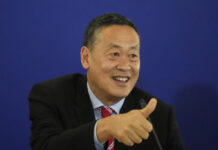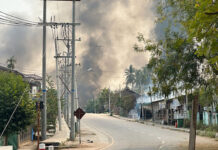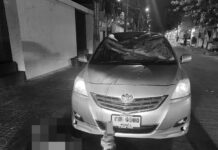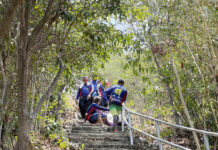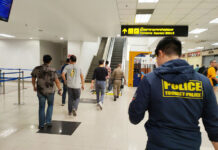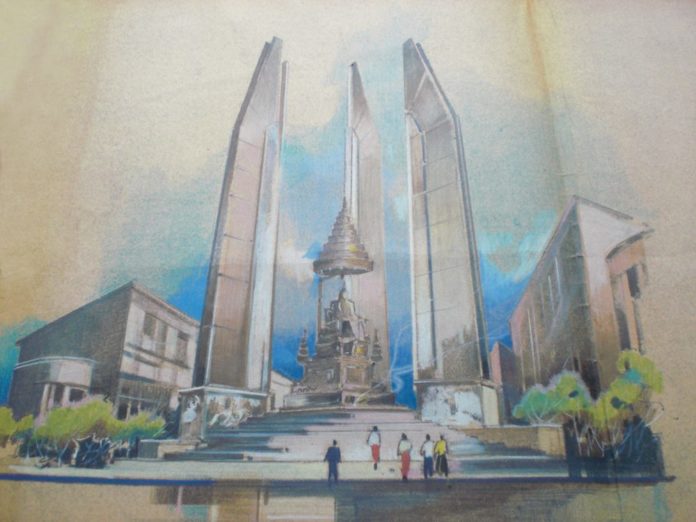
BANGKOK — The recent removals of tributes to the 1932 democratic revolution has some people nervously joking that the iconic Democracy Monument could be next.
The monument, which stands right smack in the middle of picturesque Ratchadamnoen Avenue, is safe for now, but in 1952 it almost met its end after ultraroyalist officials proposed tearing it down and replacing it with the statue of King Rama VII.
Their modest proposal nearly became reality. The project was approved by the cabinet but later killed off by the prime minister before it could happen.
“They said that since Rama VII handed down a constitution to us, why don’t we build a monument displaying that fact instead of an abstract building?” historian and architecture lecturer Chatri Prakitnonthakarn said. “They wanted it dismantled.”
Read: Monument Marking Defeat of Royalist Rebels Removed in Dead of Night
The notion that rule by the people was “royally bestowed” has become a trope of revisionist history. Thailand’s first constitution in fact resulted from a coup staged against King Rama VII’s government in June 1932, which put an end to direct royal rule in favor of a constitutional monarchy.
To commemorate the revolt, the coup plotters ordered the Democracy Monument built. It’s full of symbolism. Its radius and height of 24 meters along with 75 partially submerged cannons – what appear fence posts – reference the Buddhist year of 2475 (1932); the Naga figures around the memorial represent 1932’s zodiac, Year of the Dragon.
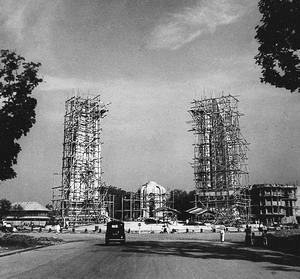
But by 1952, after a series of coups, the revolutionaries had been sidelined from power, and the government stacked with royalist generals. They soon set their sights on what to them was a massive eyesore.
A committee was convened to facilitate what the government called a “renovation” project. Led by interior affairs minister Banyat Thephasadin Na Ayutthaya, the group called for a gigantic statue of King Rama VII to be erected in place of the monument.
According to one account, the government wasn’t going alone. Kasetsart University historian Sarunyou Thepsongkraow wrote in Art and Culture Magazine in 2013 that there was evidence the royal household bureau was urging officials to make it happen.
In the end, it was Prime Minister Plaek Pibulsongkram who left us with the monument still highlighted in every travel guide. He simply told the cabinet the treasury couldn’t afford it. In February 1953, the plan was put on indefinite hold.
The grand renovation plan was raised again by the military dictators of 1969, but a popular uprising – in which the Democracy Monument was a rallying point – toppled the regime four years later, again killing the idea.
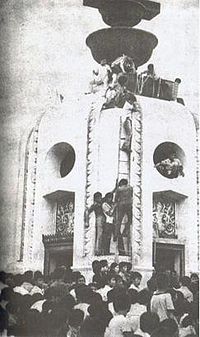
“After Oct. 14 incident, the monument got a new meaning as a true icon of democracy,” Chatri the historian said. “Its place of prominence was secured.”
The government did end up building the statue of King Rama VII originally designed for the monument, albeit in smaller size. The statue was placed in front of the parliament building, which is closing forever Monday.
So is the Democracy Monument’s future secure? Chatri thinks it would be difficult to remove such an iconic landmark, but after what befell the Constitution Defense Monument, he is less sure now.
“I wasn’t that shocked when I heard the news, actually,” the lecturer said. “I always thought its end would come, eventually.”
Correction: An earlier version of this year misidentified 1932 as the Year of Serpent. In fact, it was the Year of the Dragon.








